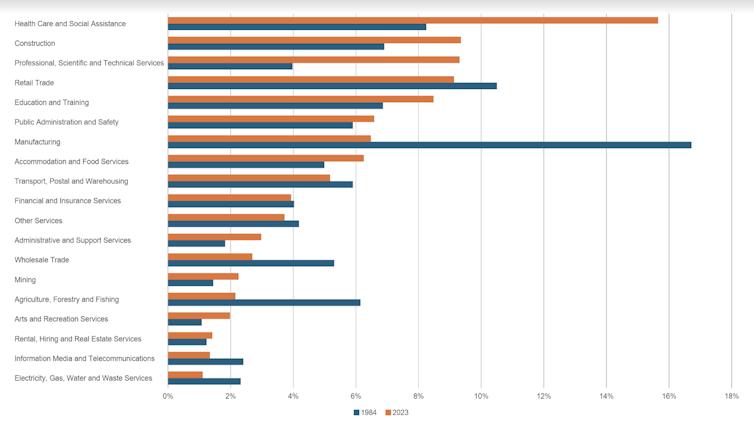In a rustic like Australia, all of us count on that once we get previous, we’ll be capable of depend on a sturdy aged care system. However aged care suppliers can’t discover employees and a disaster is brewing.
If the issue isn’t mounted, there are severe dangers to high quality and entry to providers for older individuals who want help. There are additionally broader social, financial and political penalties for undervaluing the quickly increasing well being and social help workforce.
Aged care employs round 420,000 individuals. Round 80% of these are entrance line employees offering care and demand for them is rising quickly.
Australians are ageing
The variety of individuals aged 80 and over is projected to double by 2050. On the similar time, casual household care is turning into much less out there. Within the subsequent 25 years, twice as many aged care employees shall be wanted.
At the moment, about 1.4 million older individuals obtain aged care providers, together with fundamental and extra intensive house care and residential care.
Well being care and social help job vacancies and advertisements are the best of any business. Between 30,000 and 35,000 extra direct aged care staff a yr are already wanted. By 2030 the shortfall is more likely to be 110,000 full time equal staff.
Why don’t sufficient individuals wish to work in aged care?
Regardless of current pay will increase, it’s tough to draw and retain aged care staff as a result of the work is under-valued.
The Australian workforce is present process profound change. A era in the past, manufacturing made up 17% of the workforce. At the moment it has fallen to six%. In contrast, the well being care and social help workforce has doubled from 8% to 16%.

ABS 6291.0.55.001 Labour Power, Australia.
Manufacturing jobs have been primarily safe, full-time, moderately paid jobs dominated by male staff.
In contrast, jobs in aged care are sometimes insecure, part-time and poorly paid, dominated by girls, with many staff coming from non-English talking backgrounds.
Since shifting to take over aged care within the Nineteen Eighties, the federal authorities has over-emphasised price constraint via service privatisation, activity-based funding and competitors, usually below the quilt of shopper selection.
The result’s a extremely fragmented and poorly coordinated aged care sector with virtually 3,200, usually small and under-resourced suppliers centrally funded and controlled from Canberra.
This has led to excessive ranges of casualisation, low funding in coaching {and professional} growth, and insufficient supervision, significantly within the house care sector.
Aged care is going through an ideal storm. Demand for care and help employees is rising dramatically. The sector is poorly coordinated and tough to navigate. Pay and situations stay poor and the workforce is comparatively untrained. There aren’t any minimal requirements or registration necessities for a lot of front-line aged care employees.
What are the results?
An understaffed and under-trained aged care workforce reduces entry to providers and the standard of care and help.
Aged care suppliers routinely report it’s tough to draw employees they usually can’t meet the rising demand for providers from older individuals.
Employees shortages are already having an influence on residential care occupancy charges falling, with some regional areas now all the way down to solely 50% occupancy.

africa_pink/Shutterstock
Which means older individuals both don’t get care or they’re at elevated danger of neglect, malnutrition, avoidable hospital admissions and a poorer high quality of life.
Inevitably, lack of aged care staff places strain on hospital providers when older individuals have nowhere else to go.
What must be achieved?
Addressing these challenges requires a multifaceted strategy. Australia will want a large enhance within the variety of aged care staff and the standard of the care they supply. Wages should be aggressive to draw and retain employees.
However higher pay and situations is just a part of the story. Until aged care turns into a profession the neighborhood recognises, values and helps, it’ll proceed to be tough to coach, appeal to and retain employees.
The current Royal Fee on Aged Care High quality and Security highlighted the necessity for a extra expert workforce, emphasising the significance of ongoing skilled growth for all employees.
Up to now the federal authorities’s aged care workforce initiatives have been underwhelming. They’re a restricted and piecemeal moderately than a coherent workforce technique.
Within the brief time period, expert migration could also be a part of the answer. However progress to usher in expert aged care staff has been glacial. At the moment solely about 1% of suppliers have agreements to usher in employees from abroad. At finest, abroad migration will meet solely 10% of the workforce shortfall.
Registration, {qualifications} and coaching for direct care work should turn out to be obligatory to verify care requirements are met.
Way more vital and systematic incentives and help for coaching shall be wanted. Supervision, profession development and employees growth will even should be dramatically improved if we’re to draw and retain the workforce that’s wanted.
“Be taught and earn” incentives, together with scholarships and traineeships for aged care, are wanted to draw the longer term workforce.
On the similar time, a much wider funding in upskilling all the workforce via persevering with skilled growth and good high quality supervision is important.
Like manufacturing a era in the past, aged care must turn out to be valued, expert, safe and well-paid employment if it’s going to appeal to the employees which might be wanted to keep away from a looming disaster.

